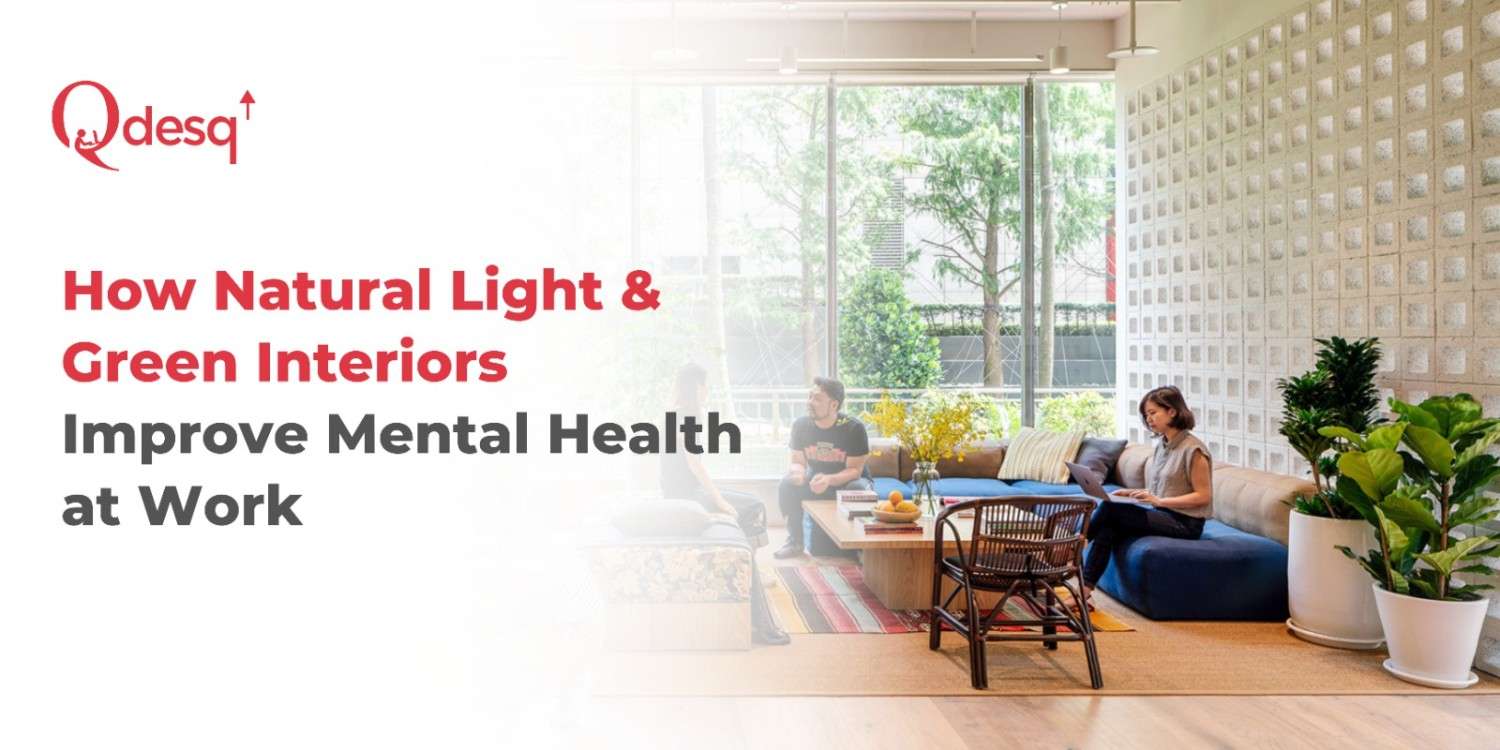Sunlight is a plentiful yet often underestimated element essential to human health and wellness. After the COVID pandemic, as most companies are shifting to remote work, the need for natural light in built environments has never been more critical. Designers and architects must recognise how deeply daylight affects mental well-being. Encouragingly, a growing body of research, case studies, and evolving design standards continue to emphasise the unique role of natural light in enhancing health, focus, and overall happiness. In this blog, we’ll go through the benefits of coworking in daylight.
Sunlight exposure | The Brain’s release of serotonin
Natural light plays a vital role in supporting mental health. When we’re exposed to daylight, our brains produce more serotonin, which elevates mood and enhances focus and calm. A study by Future Workplace revealed that 78% of employees feel better when they have access to natural light and outdoor views. Surprisingly, this simple feature outranked more high-profile workplace perks like on-site gyms and advanced tech.
Similarly, being around greenery has a measurable effect on stress levels. Research published in Scientific Reports showed that 20 minutes spent in a natural setting can significantly reduce cortisol, the hormone linked to stress. For employees, carving out time in or near green spaces can offer a refreshing mental reset, making the workday feel less draining and more balanced.
Nature improves cognitive function
We spend most of our time indoors, and less than 8% of our day is spent outside. As urban living grows, with 70% of the global population expected to live in cities by 2050, our disconnection from nature may have cognitive consequences. Research shows that our brains benefit from green environments in key ways:
- Nature lowers stress: Just 15 minutes in a forest can reduce stress hormones and heart rate. Even plant scents help calm the nervous system.
- It encourages kindness: Studies show people become more generous and empathetic after viewing nature. Kids in green settings even read social cues better.
- It boosts brain function: Time outdoors improves memory, focus, and flexibility. Nature exposure has been shown to help children with ADHD concentrate more effectively.
Natural light offers physical health benefits
Sunlight does more than brighten your day. It plays a vital role in overall health. It helps your skin produce vitamin D, which supports strong bones, immune function, and brain health. Regular exposure to sunlight can improve sleep by regulating your internal clock and boost mood by increasing serotonin levels. Sunlight also lowers stress, may reduce blood pressure, and even helps clean indoor air by killing bacteria in dust. Some studies suggest it supports weight control and reduces the risk of osteoporosis and multiple sclerosis. Simply put, a little sunshine each day goes a long way.
Reduced turnover and higher retention rates
Better mental health, higher productivity, and improved physical well-being increase job satisfaction. Employees working in spaces with plenty of natural light and eco-friendly features often feel more engaged. That kind of engagement doesn’t just lift morale; it also tends to lower turnover and help companies keep their best people.
What Are Green Walls?
Also known as living walls or vertical gardens, green walls are exactly what they sound like: walls brought to life with lush vegetation. These vertical installations are supported by either hydroponic or soil-based systems, allowing plants to thrive on otherwise plain surfaces. Whether indoors or out, they turn walls into living ecosystems, blending nature with architecture in an eye-catching and functional way.
How Green Walls Are Fostering Creativity
- They help you focus. That calming vibe that plants in workspaces give off? It’s real. Green walls can ease stress and help you stay locked in longer when working or studying.
- They spark creativity. Being around greenery can help you think more freely, which is great for brainstorming or coming up with fresh ideas.
- They dial down stress. Spending time near plants has lowered cortisol levels, helping you feel more relaxed and balanced.
- They freshen the air. Plants naturally pump out oxygen, making the space feel cleaner and easier to breathe.
- They keep things comfy. Green walls help regulate indoor temperatures, so you don’t need to crank the heat or AC as much.
- They quiet things down. All that greenery helps absorb noise, especially in busy or loud environments.
- They make you feel better. People tend to feel happier and healthier in green spaces; it’s a subtle but powerful mood boost.
Why Green Walls Are Good for the Planet
- Fights climate change: Plants on green walls absorb carbon dioxide, helping reduce greenhouse gases.
- Cleans the air: They act like natural filters, soaking up pollutants and making the air healthier.
- Keeps cities cooler: Green walls can help cool down hot urban areas by lowering surface temperatures.
- Manages rainwater: They absorb rain, which reduces runoff and helps prevent flooding.
- It looks great: Beyond the benefits, they make spaces more beautiful and inviting.
- Brings nature indoors: Green walls tap into our natural love for greenery, making indoor spaces feel more alive and connected to the outdoors.
Adding green walls isn’t just suitable for people; it’s a smart step toward a more sustainable, livable future.
Why Biophilic Design Belongs in Every Mental Health Office
Designing a workplace that supports mental well-being isn’t just about colours and furniture; it’s about creating a space that genuinely helps people feel better. That’s where biophilic design comes in. It’s not just a buzzword; it’s a thoughtful way to bring elements of nature indoors to boost comfort, productivity, and peace of mind, central to any effective mental health office design. Here’s what makes a difference:
- Prioritise Natural Light and Scenic Views
Let’s face it: working in a dim, enclosed office doesn’t favour anyone. Natural light helps regulate our internal clocks, which means better sleep and more energy during the day. People with access to daylight in the office reportedly sleep almost an hour longer at night. And if that light comes with a view of trees or even a patch of greenery? Even better. Just glimpsing nature now and then can lower stress levels and speed up mental recovery.
- Add Life with Plants and Greenery
Plants aren’t just decorative; they’re surprisingly powerful. From purifying the air to boosting oxygen levels and even lowering cortisol (that pesky stress hormone), greenery can transform a space’s feelings. Whether a leafy plant on a desk or a vertical garden on the wall, that touch of nature can sharpen focus and bring a welcome sense of calm to a busy office.
- Use Natural Materials That Feel Grounding
There’s something inherently soothing about wood grain or the cool texture of stone. These natural materials have a grounding effect; they remind us to be outdoors, which can help reduce anxiety and improve mood. Even shapes matter: gentle curves and organic lines offer visual relief from the harsh geometry found in many offices. It’s all about creating spaces that feel more human and less mechanical.
- Appeal to All the Senses, Not Just Sight
Great design isn’t just something you see, feel, hear, and smell. Soft nature sounds or trickling water can mask distracting background noise and help people focus. Natural scents like cedarwood or eucalyptus can create an atmosphere of calm without being overwhelming. When done right, these sensory touches go a long way in shaping how a space feels emotionally.
- Make It Easy to Connect with Nature
The best workplaces don’t shut nature out; they invite it in. Think terraces, patios, or even green rooftops where people can step out for a break. Inside, design layouts that include plant clusters or skylights can encourage movement and create pockets of space where people naturally gather, relax, or recharge.
- Build Quiet Spaces and Mental Health Support
Finally, even the most beautiful design won’t mean much without spaces for rest and reflection. Wellness rooms with soft lighting, cosy materials, and a window view allow employees to breathe. Pair that with mental health support, like mindfulness sessions or stress-relief workshops, and you’re not just designing a space. You’re cultivating a culture of care.
Final Words
In today’s high-pressure, fast-paced work environments, creating spaces that support mental, physical, and emotional well-being is no longer optional; it’s essential. Natural light, green interiors, and biophilic design aren’t just aesthetic upgrades; they’re science-backed interventions that enhance focus, reduce stress, and promote healthier, happier teams. Each element plays a critical role in shaping a more human-centric workplace, from the mood-lifting power of sunlight to the brain-boosting effects of nature and the quiet brilliance of green walls. As businesses look to the future, investing in environments that reconnect people with nature isn’t just good design; it’s a good strategy.











